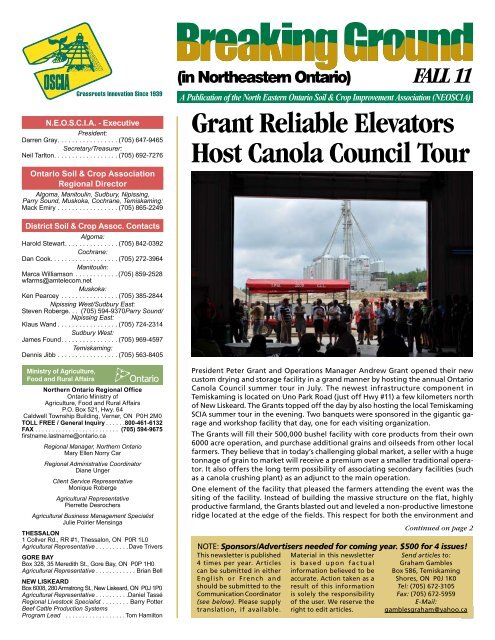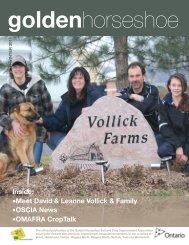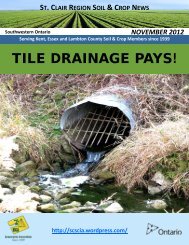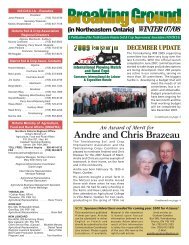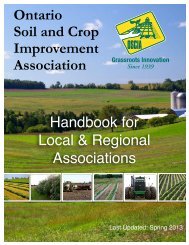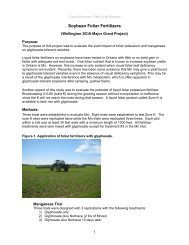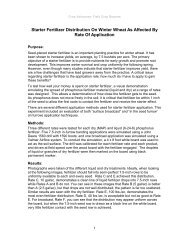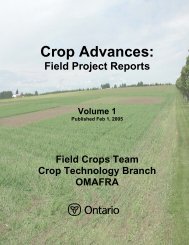Grant Reliable Elevators Host Canola Council Tour - Ontario Soil ...
Grant Reliable Elevators Host Canola Council Tour - Ontario Soil ...
Grant Reliable Elevators Host Canola Council Tour - Ontario Soil ...
Create successful ePaper yourself
Turn your PDF publications into a flip-book with our unique Google optimized e-Paper software.
Grassroots Innovation Since 1939<br />
N.E.O.S.C.I.A. - Executive<br />
President:<br />
Darren Gray. ............... (705) 647-9465<br />
Secretary/Treasurer:<br />
Neil Tarlton. ................ (705) 692-7276<br />
<strong>Ontario</strong> <strong>Soil</strong> & Crop Association<br />
Regional Director<br />
Algoma, Manitoulin, Sudbury, Nipissing,<br />
Parry Sound, Muskoka, Cochrane, Temiskaming:<br />
Mack Emiry.. . . . . . . . . . . . . . . . (705) 865-2249<br />
(in Northeastern <strong>Ontario</strong>) FALL 11<br />
A Publication of the North Eastern <strong>Ontario</strong> <strong>Soil</strong> & Crop Improvement Association (NEOSCIA)<br />
<strong>Grant</strong> <strong>Reliable</strong> <strong>Elevators</strong><br />
<strong>Host</strong> <strong>Canola</strong> <strong>Council</strong> <strong>Tour</strong><br />
District <strong>Soil</strong> & Crop Assoc. Contacts<br />
Algoma:<br />
Harold Stewart. ............. (705) 842-0392<br />
Cochrane:<br />
Dan Cook. . . . . . . . . . . . . . . . . . . (705) 272-3964<br />
Manitoulin:<br />
Marca Williamson .. . . . . . . . . . . (705) 859-2528<br />
wfarms@amtelecom.net<br />
Muskoka:<br />
Ken Pearcey.. . . . . . . . . . . . . . . (705) 385-2844<br />
Nipissing West/Sudbury East:<br />
Steven Roberge. . . (705) 594-9370Parry Sound/<br />
Nipissing East:<br />
Klaus Wand................. (705) 724-2314<br />
Sudbury West:<br />
James Found. .............. (705) 969-4597<br />
Temiskaming:<br />
Dennis Jibb . ............... (705) 563-8405<br />
Ministry of Agriculture,<br />
Food and Rural Affairs<br />
Northern <strong>Ontario</strong> Regional Office<br />
<strong>Ontario</strong> Ministry of<br />
Agriculture, Food and Rural Affairs<br />
P.O. Box 521, Hwy. 64<br />
Caldwell Township Building, Verner, ON P0H 2M0<br />
TOLL FREE / General Inquiry...... 800-461-6132<br />
FAX.. . . . . . . . . . . . . . . . . . . . . . . . . (705) 594-9675<br />
firstname.lastname@ontario.ca<br />
Regional Manager, Northern <strong>Ontario</strong><br />
Mary Ellen Norry Car<br />
Regional Administrative Coordinator<br />
Diane Unger<br />
Client Service Representative<br />
Monique Roberge<br />
Agricultural Representative<br />
Pierrette Desrochers<br />
Agricultural Business Management Specialist<br />
Julie Poirier Mensinga<br />
THESSALON<br />
1 Collver Rd., RR #1, Thessalon, ON P0R 1L0<br />
Agricultural Representative.......... Dave Trivers<br />
GORE BAY<br />
Box 328, 35 Meredith St., Gore Bay, ON P0P 1H0<br />
Agricultural Representative.............Brian Bell<br />
NEW LISKEARD<br />
Box 6008, 280 Armstrong St., New Liskeard, ON P0J 1P0<br />
Agricultural Representative.......... Daniel Tassé<br />
Regional Livestock Specialist.. . . . . . . . Barry Potter<br />
Beef Cattle Production Systems<br />
Program Lead ................. Tom Hamilton<br />
President Peter <strong>Grant</strong> and Operations Manager Andrew <strong>Grant</strong> opened their new<br />
custom drying and storage facility in a grand manner by hosting the annual <strong>Ontario</strong><br />
<strong>Canola</strong> <strong>Council</strong> summer tour in July. The newest infrastructure component in<br />
Temiskaming is located on Uno Park Road (just off Hwy #11) a few kilometers north<br />
of New Liskeard. The <strong>Grant</strong>s topped off the day by also hosting the local Temiskaming<br />
SCIA summer tour in the evening. Two banquets were sponsored in the gigantic garage<br />
and workshop facility that day, one for each visiting organization.<br />
The <strong>Grant</strong>s will fill their 500,000 bushel facility with core products from their own<br />
6000 acre operation, and purchase additional grains and oilseeds from other local<br />
farmers. They believe that in today’s challenging global market, a seller with a huge<br />
tonnage of grain to market will receive a premium over a smaller traditional operator.<br />
It also offers the long term possibility of associating secondary facilities (such<br />
as a canola crushing plant) as an adjunct to the main operation.<br />
One element of the facility that pleased the farmers attending the event was the<br />
siting of the facility. Instead of building the massive structure on the flat, highly<br />
productive farmland, the <strong>Grant</strong>s blasted out and leveled a non-productive limestone<br />
ridge located at the edge of the fields. This respect for both the environment and<br />
Continued on page 2<br />
NOTE: Sponsors/Advertisers needed for coming year. $500 for 4 issues!<br />
This newsletter is published<br />
4 times per year. Articles<br />
can be submitted in either<br />
English or French and<br />
should be submitted to the<br />
Communication Coordinator<br />
(see below). Please supply<br />
translation, if available.<br />
Material in this newsletter<br />
i s b a s e d u p o n fa c tual<br />
information believed to be<br />
accurate. Action taken as a<br />
result of this information<br />
is solely the responsibility<br />
of the user. We reserve the<br />
right to edit articles.<br />
Send articles to:<br />
Graham Gambles<br />
Box 586, Temiskaming<br />
Shores, ON P0J 1K0<br />
Tel: (705) 672-3105<br />
Fax: (705) 672-5959<br />
E-Mail:<br />
gamblesgraham@yahoo.ca<br />
1
Breaking Ground<br />
Continued from page 1<br />
the sanctity of rich agricultural soils will<br />
be appreciated for generations.<br />
The <strong>Canola</strong> <strong>Council</strong> summer tour has become<br />
a major attraction, with attendees<br />
from across the Province. A huge contingent<br />
from the South were very impressed<br />
with production in the North this year, as<br />
many had been decimated by drought<br />
conditions that had covered their farms<br />
this year. They spent a sunny morning<br />
touring the <strong>Grant</strong> canola fields, listening<br />
to company reps, then held an indoor<br />
slide show event in the cool of the garage<br />
facility in the afternoon, followed by attending<br />
the TSCIA evening bus tour that<br />
closed off the day.<br />
Ben Schapelhouman of <strong>Grant</strong> Farms led<br />
off the mornings talks by sharing his onsite<br />
experience with the assembled guests<br />
in mid-field. He noted that the area soils<br />
have a natural shortage of sulphur that<br />
has to be improved upon for ideal crop<br />
production. They have been using granular<br />
sources of sulphur in the past, but<br />
are now moving to liquid formulations.<br />
They are also trying “biosolid” pelletized<br />
products from the City of Toronto, but<br />
these are limited by the unpredictability<br />
of their slow release organic content.<br />
Equipment has been upgraded with the<br />
purchase of a massive new tractor (on<br />
treads to reduce soil compaction) and a<br />
Morris contour drill. All fields will use the<br />
“tram line” spraying concept to maximize<br />
chemical efficiency.<br />
(in Northeastern <strong>Ontario</strong>)<br />
<strong>Grant</strong> <strong>Reliable</strong> <strong>Elevators</strong> <strong>Host</strong> <strong>Canola</strong> <strong>Council</strong> <strong>Tour</strong><br />
Bayer Crop Science rep Marieke Patton<br />
spoke about the work and time involved<br />
to test their extensive replicated trials<br />
around the Province. She also informed<br />
the growers that all “Invigor” lines for<br />
“Liberty Link” products will in the future<br />
be identified with the letter “L” (such as<br />
L159). The Brett Young company from<br />
Manitoba was represented by the staff of<br />
Labonte Seed (New Liskeard). A highlight<br />
of their chemical line-up is a product<br />
called “Jump-Start” that encourages<br />
early emergence. Local Co-Op rep Terry<br />
Phillips noted that the crop value was<br />
high this year. He commented that canola<br />
growers should be considering boron as<br />
a stress relief for farms where hot weather<br />
was common, as boron could reduce<br />
flower abortion. Janet Porchak of UAP<br />
spoke to the Sclerotinia issue and the<br />
fungicides that could combat the problem.<br />
UAP carries “Serenade”, that has<br />
the same timing as “Proline”. It is from a<br />
different group of fungicides, making a<br />
rotation of chemicals possible.<br />
A new canola harvest management system<br />
is being tried. Instead of swathing,<br />
they are ‘pushing’ canola. This is the intentional<br />
lodging of the crop. It turns the<br />
ripening crop into a thick mat about a<br />
foot off the ground. The result is a reduction<br />
in pod shatter during the combine<br />
harvest. An alternative to reduce pod<br />
shatter is to apply “Podseal”.<br />
COMING EVENTS<br />
RAIN Agriculture and<br />
Agri-Food Symposium<br />
The Sault Ste. Marie Innovation Centre<br />
and NORDIK Institute are hosting an<br />
Agriculture and Agri-Food Symposium on<br />
November 4th and 5th at Algoma<br />
University in Sault Ste. Marie. The symposium<br />
aims to create opportunities<br />
for collaboration between farmers in<br />
Northern <strong>Ontario</strong> and researchers in the<br />
agricultural sector. The symposium will<br />
feature presentations and panel discussions<br />
for local farmers and researchers<br />
alike. Topics include:<br />
• Policies and Programs to Grow<br />
Agricultural Capacity in the North<br />
• Sustaining <strong>Soil</strong> and Crop Productivity<br />
• Crop Trials in Northern <strong>Ontario</strong><br />
• Specialty Foods and Value-<br />
Added Products<br />
• Livestock Production in<br />
Northern <strong>Ontario</strong><br />
•Healthy Food for Sustainable<br />
Communities<br />
Challenges and Opportunities<br />
Speakers for the two day symposium<br />
include Keynote Speaker Ron Bonnett<br />
(President of Canadian Federation of<br />
Agriculture) who will talk about the future<br />
of agriculture in Northern <strong>Ontario</strong><br />
from local and international perspectives.<br />
Other speakers include Dr. Pedro<br />
Antunes ( Algoma University ), Dr. Tarlok<br />
Sahota (Thunder Bay Research Station),<br />
Dr. Connie Nelson (Food Security Research<br />
Network), and Ira Mandell (U of Guelph)<br />
and others. For a full agenda of the<br />
event, visit rainsymposium.evenbrite.com<br />
This event is sponsored by the National<br />
Sciences and Engineering Research <strong>Council</strong><br />
of Canada, the Community Development<br />
Corporation of Sault Ste Marie and the<br />
University of Guelph<br />
Registration is $50 and includes meals.<br />
Errol Caldwell<br />
Research Director<br />
Telephone: 705 942-7927, ext. 3147<br />
2
Breaking Ground (in Northeastern <strong>Ontario</strong>) Committed to<br />
Stratford<br />
Agri Analysis Sustainable<br />
In association with<br />
Northern Feed &Supplies Ltd.<br />
New Liskeard Agriculture<br />
Offers<br />
OMAFRA accredited<br />
weed management. <strong>Soil</strong> Sampling Uncontrolled & Analysis<br />
weed<br />
seed production could have a negative<br />
effect on nearby Your farms. key Control to better of this<br />
problem can be achieved<br />
Yield<br />
by chemical,<br />
mechanical, or grazing solutions. It is<br />
up to the farm community Profit to insist that<br />
the new neighbours have Stewardship<br />
an acceptable<br />
www.temiskamingshores.ca<br />
means of control.<br />
Call Jason at<br />
1-705-672-3363<br />
The second limitation is the loss of the<br />
agricultural land base to non-agricultural<br />
(705) 647-5365<br />
competing interests. True, it is no different<br />
than the pressure on farmland evident<br />
in encroaching suburbs and industrial<br />
parks, but it is an economic loss to the<br />
AGRICULTURAL community all the same.<br />
Note that the area taken up by the generating<br />
units is much less than the entire CO-OPÉRATIVE RÉGIONALE<br />
area of the current farms. What happens<br />
DE NIPISSING-SUDBURY LIMITED<br />
to those pasture and cropland areas that<br />
will be held in reserve<br />
ALGOMA<br />
Algoma AG Center<br />
Consideration by the proponent - and municipal<br />
authorities - should be given to the<br />
Toll Free: 1-800-361-9255<br />
Tel: 705-248-2201 Fax: 705-248-1109<br />
proper economic management of all parts<br />
THORNLOE<br />
of the energy farm. Yes, by all means develop<br />
the site for energy production, but<br />
Tem AG Center<br />
Tel: 705-647-6639 Fax: 705-647-9699<br />
Toll Free: 1-800-861-7217<br />
build a viable agricultural management<br />
option into the overall site management<br />
VERNER<br />
Verner AG Center<br />
scheme. Elsewhere in the world, the grazing<br />
of sheep around the generating units<br />
Toll Free: 1-800-361-9255<br />
Tel: 705-594-1268 Fax: 705-594-2229<br />
is the standard for weed control. Reserve<br />
lands beyond the solar cells can be used<br />
for beef production. Hay and other crops<br />
can continue to be harvested on a well<br />
managed site. What is required is the<br />
development of an agreement between<br />
the solar proponents and a farm (co-op)<br />
association. Alternatively, the hiring of<br />
a solar farm manager with agricultural<br />
experience and the authority to develop<br />
a thriving farm in conjunction with the<br />
solar production priorities would be a viable<br />
option.<br />
But it only a few hundred acres you say<br />
Right now it is, however many more solar<br />
farms in Temiskaming and across the<br />
North are proposed. All in flat, cleared,<br />
agricultural areas. What will the effect be<br />
on the farm industry within a decade It is<br />
right now that this issue must be decided<br />
so that both agricultural and solar producers<br />
can live side by side in harmony, to the<br />
benefit of each other.<br />
3 3<br />
THE SOLAR FUTURE<br />
Editorial by Graham Gambles, NEOSCIA<br />
Regional Communication Co-ordinator<br />
Across the North, there have been many<br />
solar energy production units set up on<br />
traditional farms. They usually consist of<br />
one or two units, situated on concrete<br />
bases and located near the farm buildings.<br />
Sometimes they can be seen on the roof<br />
of a strongly supported barn or machinery<br />
shed. They co-exist with and enhance the<br />
viability of the family farm. The structures<br />
are a product of the Provincial MICROFIT<br />
energy production opportunity that<br />
(most) landowners are allowed to join.<br />
However, there is a new solar energy production<br />
program that is about to make an<br />
appearance in the North. These large scale<br />
energy production facilities are part of the<br />
“FIT” (Feed-in-Tariff) Provincial program.<br />
Individually, these units are no larger than<br />
those that individual farmers are erecting<br />
under the Micro-Fit program, but they<br />
are constructed in large herds that will<br />
dominate the landscape, depending on<br />
the angle that they are viewed!<br />
This feature has been proposed for<br />
three farms on the western outskirts of<br />
Temiskaming Shores. Each will produce<br />
a total of 10MW energy. Operated by<br />
Canadian Solar Solutions Inc., the site is<br />
proposed to be developed in the next two<br />
years. One farm will be on abandoned<br />
land adjacent to a former garbage dump,<br />
but the next two will be on class three and<br />
four farmland currently used for livestock<br />
(beef) production. (Note that government<br />
legislation prevents these facilities from<br />
being built on class 1 and 2 land.)<br />
On the face of it, this appears to be a<br />
good opportunity for all. The original land<br />
owners have received excellent payment<br />
for their property. A number of jobs will<br />
be created during construction, although<br />
only part time property management jobs<br />
will be available over the 20 year life of<br />
the project. The sites will be cleaned up<br />
and restored to agricultural purposes at<br />
the end of the production period (unless<br />
a new generation contract is put in<br />
place). The properties will be fenced off<br />
to protect the public from straying into an<br />
electrical generation area. The municipality<br />
will receive taxes. The solar company<br />
will make money on their investment.<br />
There are only two potential shortcomings<br />
that can be seen at this point. First is
Breaking Ground<br />
(in Northeastern <strong>Ontario</strong>)<br />
Nipissing University<br />
Agricultural Research Project<br />
Receives Provincial Approval<br />
by Dan Walters, Ph.D., Associate Professor of<br />
Geography, Nipissing University<br />
While collaboration between farmers<br />
in north eastern <strong>Ontario</strong> and faculty at<br />
Nipissing University began nearly three<br />
years ago, we can now announce the official<br />
beginning of the research project<br />
in web-based visualization and decision<br />
support for agriculture. In July we received<br />
notice from FedNor that financial<br />
support was not forthcoming. We were<br />
obviously very disappointed with their<br />
decision. However, despite this setback,<br />
NOHFC were willing to increase their percent<br />
coverage of eligible expenses. With<br />
this decision, we can continue to employ<br />
undergraduate and graduate students to<br />
assist with field work and software development.<br />
Three graduate students will<br />
begin this fall at Nipissing University’s new<br />
Master’s of Environmental Studies (MES)<br />
and Master’s of Environmental Science<br />
(MESc) program.<br />
We had an opportunity to give a brief update<br />
at the Temiskaming Crops Coalition<br />
Crop <strong>Tour</strong>, hosted by <strong>Grant</strong> Farms, and the<br />
Verner Crops <strong>Tour</strong>. Recent project developments<br />
include an additional weather<br />
station in Belle Valley, new imagery, and<br />
major improvements to the software. To<br />
access the weather data please go to the<br />
following website: http://www.nipissingu.<br />
ca/weather. We hope to install an additional<br />
weather station in Charlton this fall.<br />
Over the winter, we will be asking you for<br />
your input on data accessibility, software<br />
design, and data visualization. We want<br />
to know how to improve access and availability<br />
of relevant information. Also, we<br />
need to identify locations in Verner and<br />
Temiskaming Shores to install a network<br />
of soil moisture probes. We appreciate<br />
all the comments and suggestions given<br />
thus far. Please continue to share<br />
with us how you are using the information<br />
on the website. We want to thank<br />
Stephen Roberge and Norm Koch Farms<br />
for their support continuing of research<br />
projects this year. In the interim, if you<br />
should have any comments or suggestions,<br />
please do not hesitate to contact<br />
Dr. Mark Wachowiak (705-474-3450 ext.<br />
4115; markw@nipissingu.ca) or Dr. John<br />
Kovacs (705-474-3450 ext.4336; johnmk@<br />
nipissingu.ca).<br />
TCC Annual Meeting<br />
The Temiskaming Crop Coalition (of which<br />
Temiskaming <strong>Soil</strong> and Crop Improvement<br />
Association is a partner) has decided to<br />
delay their normal November annual meeting<br />
for a couple of months. It is proposed<br />
that it will run on January 12, 2012, at the<br />
Kerns Hall. The reason for the change is to<br />
accommodate a request from the northern<br />
district of the <strong>Ontario</strong> Grain Growers to<br />
hold the meetings of the two organizations<br />
together.The members of the groups<br />
are interlinked, and this is one way that we<br />
can reduce the number of meetings that<br />
many volunteers are required to attend.<br />
The specifics will run in the Christmas edition<br />
of Breaking Ground.<br />
Save Your Seed!<br />
As harvest is nearing an end, now is the<br />
time to save samples of your best canola,<br />
wheat, barley, and any other crop that<br />
you have grown. WHY Each spring, many<br />
of our local districts feature a "forage and<br />
seed show". Right now, you know where<br />
your best material is being kept. Before it<br />
moves off the farm, collect a few litres of<br />
your best and stash them away for future<br />
displays and competition. It is also worthwhile<br />
to hang onto a sample or two for<br />
the long term as a ready comparison to<br />
different varieties that may be planted<br />
sometime in the future.<br />
Likewise, identify and save that special sample<br />
of forage that you would like to brag<br />
about next spring. It would be in a whole<br />
different competition if it has already been<br />
fed to the livestock before the main event!<br />
Marieke Patton<br />
Territory Sales Manager<br />
Cell: 519-766-5205<br />
marieke.patton@bayercropscience.com<br />
www.bayercropscience.ca/InVigor<br />
Nothing outperforms<br />
InVigor!<br />
Remember to book your<br />
InVigor Hybrids this fall!<br />
DARREN GRAY<br />
New Liskeard, <strong>Ontario</strong><br />
705-676-6710<br />
Quality Seeds Ltd.<br />
8400 Huntington Road<br />
RR #1 Woodbridge <strong>Ontario</strong> L4L 1A5<br />
905-856-7333, 1-877-856-7333<br />
support@qualityseeds.ca,<br />
www.qualityseeds.ca<br />
4
Breaking Ground<br />
(in Northeastern <strong>Ontario</strong>)<br />
Farm<br />
Le Centre Laitier du Nord<br />
TCC (TSCIA)Bus <strong>Tour</strong><br />
by Graham Gambles, NEOSCIA Regional<br />
Communication Co-ordinator<br />
The Temiskaming Crop Coalition held<br />
its annual summer crop tour on the<br />
evening of July 21, following a wonderful<br />
BBQ hosted by <strong>Grant</strong> Farms at<br />
their new drying and storage facility.<br />
Earlier in the day, many TCC members<br />
were part of the annual <strong>Canola</strong><br />
Crop <strong>Tour</strong>. That event also featured a<br />
“combine clinic” presented by Les Hill<br />
of the Prairie Agricultural Machinery<br />
Institute, with the assistance of Jihn<br />
Deere & CASE Tec Engineers. Topics<br />
discussed started with the basic combine<br />
functions, and then proceeded<br />
to the crucial topic of understanding<br />
“Combine Loss”. Farmers need to<br />
understand what their loss is telling<br />
them about the combine performance,<br />
based on where the loss is coming<br />
from and how to quantify the loss.<br />
As Hill said, “Unless you get out and<br />
measure loss on the ground, you have<br />
no idea what the monitor is telling<br />
you!” He then proceeded to step by<br />
step combine adjustments to determine<br />
what to look for and where to<br />
make the changes.<br />
The bus tour first viewed the <strong>Grant</strong><br />
Farms wheat plot variety trial, which<br />
was followed by an evaluation of<br />
Don and Laurie McLean’s Barley crop<br />
and Prescott Oat field. The nearby<br />
NEOSCIA Bedstraw control plots<br />
that features the use of the chemical<br />
“Milestone” was visited.<br />
Dave Schill and Wayne Brubacher invited<br />
the participants into their Corn<br />
plot variety trial just prior to Terry<br />
Phillips discussion of his Soybean crop.<br />
Terry also spoke on his twin solar collection<br />
panels that are located beside<br />
his house. As twilight descended, the<br />
tour walked along Dave Schill’s Spring<br />
Wheat Variety Trial where the replicated<br />
tests provided a great visual<br />
evaluation of the differences between<br />
the varieties. (We can hardly wait for<br />
the production results!) The evening<br />
was capped off with a return to the<br />
<strong>Grant</strong> elevator, where the remaining<br />
treats and pops were dealt with.<br />
Dairy Centre of the North<br />
invites Everyone to the Farm<br />
Show & Conference<br />
April 8 & 9, 2011<br />
at the Earlton Arena<br />
Credit Canada<br />
Financement<br />
agricole Canada<br />
Agriculture…<br />
It’s all we do.<br />
L’agriculture…<br />
notre raison d’être.<br />
1-800-387-3232<br />
5
Breaking Ground<br />
(in Northeastern <strong>Ontario</strong>)<br />
Une dose de coopération pour soulager les maux<br />
des agriculteurs Partie 1 : l’environnement naturel<br />
Christian Howald, Agent de développement, région du Nord, Conseil de la coopération de l,Ontaio<br />
Ce texte est le premier d’une série<br />
de six articles traitant des obstacles<br />
que rencontrent les producteurs<br />
agricoles de la région de Nipissing-<br />
Sudbury. Il est le résultat d’une<br />
recherche qualitative à laquelle vingt<br />
agriculteurs de la région ont participé<br />
afin de partager les enjeux auxquels<br />
ils font face ainsi que les solutions<br />
qu’ils ont à offrir. Nous préservons<br />
l’anonymat des répondants car<br />
certains points de vue portent des<br />
jugements. De leurs entrevues sont<br />
ressortis six facteurs clés ayant un<br />
effet direct sur l’agriculture de la<br />
région : l’environnement naturel,<br />
la clientèle, la compétition, l’accès<br />
au marché, les inter ventions<br />
gouvernementales et les associations<br />
agricoles. Ce sont des facteurs<br />
qui agissent sur la capacité des<br />
agriculteurs en région de produire,<br />
faire transformer et de vendre leurs<br />
marchandises. Par-dessus tout, un<br />
élément clé ressort : les agriculteurs<br />
font eux-mêmes par tie de la<br />
solution. Ils ne sont pas de simples<br />
victimes de l’infrastructure, mais<br />
des joueurs clés d’un écosystème<br />
complexe. La solution revient à leur<br />
réinvestissement dans les valeurs<br />
coopératives, surtout l’entraide et la<br />
solidarité, abandonnées au profit de la<br />
mécanisation et de l’individualisation,<br />
un retour aux principes coopératifs<br />
qui f leurissaient en région au<br />
milieu du dernier siècle lorsque le<br />
mouvement coopératif était en plein<br />
essor dans le Nord de l’<strong>Ontario</strong>.<br />
Le premier facteur ayant un effet<br />
direct sur la rentabilité de l’agriculture<br />
dans la région de Nipissing-Sudbury<br />
est l’environnement naturel. Selon<br />
les agriculteurs questionnés, c’est<br />
14<br />
une région qui nécessite une grande<br />
adaptation. Les communautés sont<br />
peu peuplées et éparpillées sur de<br />
très grandes distances et l’hiver y est<br />
long et froid. À la base, les fermes y<br />
sont entrelacées de rochers, de cours<br />
d’eau et de forêts au lieu de former<br />
un peloton de terre esthétiquement<br />
plaisant comme les fermes du Sud.<br />
La grande culture n’y est pas aussi<br />
facile parce que les champs sont<br />
petits et parsemés et le terrain est<br />
accidenté. Les coûts de réparations<br />
des équipements reflètent directement<br />
cette situation. De même, le climat<br />
n’est pas aussi propice que dans les<br />
régions plus chaudes. Cela a un effet<br />
sur la variété des produits disponibles.<br />
En fait, la région ne jouit en moyenne<br />
que de 59 jours sans gel et un grand<br />
nombre de plantes, tel le maïs, ont<br />
besoin d’au moins 70 jours avant<br />
d’être récoltées. La faible densité de<br />
population à un effet sur l’accès à<br />
la main d’œuvre et aussi à l’accès à<br />
la clientèle. Les marchés niches de<br />
la région ne consistent souvent que<br />
de quelques personnes tandis que<br />
dans les grandes villes, les nombres<br />
s’élèvent aux milliers. De même, les<br />
coûts de transport et de livraison sont<br />
plus élevés à cause des plus grandes<br />
distances à couvrir.<br />
Cependant, les agriculteurs peuvent<br />
s’adapter à leur environnement. Ils<br />
réalisent qu’il leur faut sélectionner des<br />
produits qui prospèrent dans le climat.<br />
Certains disent que la grande culture<br />
devrait être laissée aux producteurs<br />
du Sud. La région est idéale pour<br />
le pâturage. Malheureusement, un<br />
grand nombre d’agriculteurs de la<br />
région ont complètement abandonné<br />
la production de cheptels pour des<br />
grandes cultures céréalières peu<br />
adaptées à la région. Ils ont reçu<br />
des subventions gouvernementales<br />
pour faire drainer leurs champs et<br />
y avoir accès plus tôt au printemps.<br />
Ensuite puisqu’ils n’ont plus de<br />
fumier à épandre sur leurs champs,<br />
ils emploient des engrais chimiques,<br />
au détriment de nos cours d’eau. . Le<br />
terrain de la région est semblable à<br />
celui des régions montagneuses et<br />
dans ces endroits, les agriculteurs<br />
ont réalisé depuis longtemps que<br />
les animaux sont beaucoup mieux<br />
adaptés que la machinerie.<br />
L’avantage des grandes distances<br />
et de la faible densité de population<br />
dont peuvent profiter les agriculteurs<br />
de la région, est qu’il y a encore tout<br />
un éventail de possibilités quant<br />
au développement de marchés.<br />
Contrairement aux régions où il y<br />
a déjà des centaines de producteurs<br />
qui exploitent un domaine et où<br />
les barrières institutionnelles sont<br />
manifestes, dans une région faiblement<br />
peuplée, nous pouvons encore explorer<br />
et être vecteurs de changement.<br />
Dans un esprit coopératif, les<br />
agriculteurs peuvent s’entraider avec<br />
le transport de denrées. Ils peuvent<br />
aussi se complémenter en cultivant<br />
une variété de produits et en faisant<br />
une rotation annuelle des cultures afin<br />
de prévenir la dénudation que cause<br />
la monoculture. Les opportunités<br />
permises par la production de<br />
légumes en serres semblent également<br />
illimitées. C’est en se rencontrant, en<br />
discutant et en s’entraidant qu’une telle<br />
approche peut fonctionner ; à nos bons<br />
agriculteurs de la mettre en pratique!
Breaking Ground (in Northeastern <strong>Ontario</strong>) 15<br />
Une coopérative alimentaire régionale<br />
Christian Howald, Agent de développement, région du Nord, (CCO)<br />
L’agriculture du Nord de l’<strong>Ontario</strong> génère<br />
un PIB de 190 millions de dollars annuels.<br />
Par ailleurs, avec 307 660 logements privés<br />
qui dépensent en moyenne 7 284 $ annuellement<br />
en alimentation et plus de 7<br />
millions de touristes qui passent plus de 24<br />
heures annuellement dans la région une<br />
valeur économique de plus de 2 milliards<br />
et demi de dollars est obtenue. Dans ce cas,<br />
pourquoi l’agriculture du Nord de l’<strong>Ontario</strong><br />
n’est-elle pas plus puissante C’est que 85 %<br />
de la nourriture vendue au Canada provient<br />
de fermes industrielles situées dans d’autres<br />
pays. Celle-ci est traitée comme une commodité<br />
de marché. Depuis l’avènement du<br />
libre-échange, les revenus des agriculteurs<br />
canadiens n’ont cessé de chuter tandis que<br />
ceux des multinationales explosent. Ensuite,<br />
80 % de l’argent dépensé aux supermarchés<br />
va aux distributeurs et seulement 20 % aux<br />
producteurs qui font tout le travail. C’est<br />
que l’épicerie en <strong>Ontario</strong> est contrôlée par<br />
Loblaw’s, Sobey’s et Métro. Il faut traditionnellement<br />
transiger avec leur siège social<br />
pour vendre des produits sur leurs étalages.<br />
Leurs épiceries ne vendent pas de viande du<br />
terroir parce que leur contrat de distribution<br />
stipule qu’ils ne peuvent vendre que de<br />
la viande inspectée par le gouvernement fédéral.<br />
En effet, ces épiceries se soumettent à<br />
des lois fédérales pour éviter le fardeau bureaucratique<br />
que des lois ontariennes tout<br />
aussi minutieuses pourraient engendrer.<br />
Même si la plupart des épiciers sont libres<br />
d’allouer 5 % de leurs étalages<br />
aux produits « locaux », en <strong>Ontario</strong>, la<br />
définition du mot « local » varie selon<br />
les distributeurs. Pour certains, celle-ci<br />
s’applique aux produits du Canada. Il est<br />
alors facile pour un grand producteur de<br />
contourner les définitions afin d’obtenir<br />
des produits estampillés locaux.<br />
Dans ce milieu, le lobbying politique est difficile<br />
d’autant plus que les gouvernements<br />
sont liés par des ententes internationales.<br />
Le Conseil de la coopération de l’<strong>Ontario</strong><br />
est d’avis que la solution du plein<br />
épanouissement de l’industrie agricole<br />
ontarienne se retrouve dans les valeurs<br />
coopératives, surtout l’entraide et la solidarité.<br />
Les Ontariens doivent s’approprier<br />
le processus complet de la production à la<br />
transformation jusqu’à la vente à l’étalage<br />
des produits agricoles. Il faut ajuster le<br />
système en s’appropriant le contrôle de<br />
l’alimentation régionale et effectuer un<br />
retour aux principes coopératifs.<br />
Rien de nouveau<br />
Ce n’est pas une révolution, mais une approche<br />
ayant fait ses preuves. Il existe<br />
déjà 150 coopératives de marketing agricole<br />
au Canada. De même, en 2009 fut<br />
créée la Hometown Grocers Co-operative<br />
dans le Sud-ouest ontarien, 9 épiceries<br />
ont déjà joint leur pouvoir d’achat afin<br />
de pouvoir vendre des produits de la région.<br />
Dale Kropf, l’homme à la tête du<br />
projet, affirme que de plus en plus de<br />
consommateurs souhaitent acheter des<br />
produits locaux dans le but de supporter<br />
les agriculteurs de leur région et de se<br />
protéger des rappels fréquents qui affligent<br />
les produits importés. En joignant<br />
leurs forces, ces épiciers ont réussi à signer<br />
une entente avec Sobey’s pour leur approvisionnement<br />
en produits manufacturés<br />
tout en pouvant dorénavant vendre des<br />
produits alimentaires provenant d’un<br />
rayon de moins de 60 kilomètres de leurs<br />
magasins. Pour les aliments hors saison,<br />
la coopérative a embauché un acheteur<br />
qui se rend au Marché des produits alimentaires<br />
de l’<strong>Ontario</strong> à Toronto (<strong>Ontario</strong><br />
Food Terminal) pour sélectionner les<br />
produits les plus frais.<br />
Une question de sécurité<br />
alimentaire<br />
C’est un sujet de sécurité alimentaire : il<br />
consiste à supporter les agriculteurs locaux<br />
afin qu’ils puissent continuer à offrir<br />
des produits de qualité et d’investir dans<br />
l’économie régionale tout en réduisant<br />
leur empreinte écologique. Cela nécessite<br />
une coopérative à partenaires multiples,<br />
une association autonome de personnes<br />
volontairement réunies pour satisfaire<br />
leurs aspirations et besoins économiques,<br />
sociaux et culturels communs au moyen<br />
d’une entreprise dont la propriété est<br />
collective et où le pouvoir est exercé démocratiquement.<br />
Afin d’être rentable,<br />
la coopérative doit être impliquée dans<br />
tout le processus de l’alimentation allant<br />
de la culture et la production, à la<br />
transformation, au transport et jusqu’à<br />
la vente à l’étalage et à la consommation.<br />
Développer un réseau de production, de<br />
transformation et de distribution, supporté<br />
par des consommateurs engagés<br />
et prêts à travailler ensemble permettra<br />
de rendre plus direct le contact entre le<br />
producteur et le consommateur et de conserver<br />
l’argent en région.<br />
<strong>Ontario</strong> Wildlife Damage<br />
Compensation Program<br />
On July 1, 2011 the <strong>Ontario</strong> Wildlife Damage<br />
Compensation program took effect. This<br />
program provides for enhanced compensation<br />
for livestock owners for damages<br />
caused by predators. The list of eligible livestock<br />
species has been expanded as well as<br />
the list of predators causing damage for<br />
which compensation can be paid.<br />
The underlying principal of compensating<br />
an owner with a dollar amount that reflects<br />
what it would take to replace the predated<br />
animal in the marketplace has not changed<br />
however the maximum amounts of compensation<br />
have been increased.<br />
There is no longer a requirement that the<br />
livestock owner file an affidavit with their<br />
claim however the owner will be asked for<br />
both a Farm Business Registration Number<br />
and a Premises ID number as part of the<br />
application process.<br />
The Ministry has agreed to phase in the requirement<br />
for a Farm Business Number and<br />
a Premises ID number. The phase in period<br />
will be determined in consultation with<br />
the Agriculture Wildlife Conflict Working<br />
Group and a date for implementation will<br />
be communicated to livestock owners and<br />
municipalities well in advance of the implementation<br />
of this requirement.<br />
Program guidelines and related information<br />
can be found at www.ontario.ca/predation<br />
With these changes related to predation<br />
the Protection of Livestock and Poultry<br />
from Dogs Act has also come into force.<br />
This act addresses damage to livestock<br />
and poultry caused by dogs. Of particular<br />
note is that for the purposes of this act the<br />
definition of livestock has NOT changed<br />
however the maximums for those livestock<br />
species is the same as the <strong>Ontario</strong> Wildlife<br />
Damage Compensation program.<br />
Traceability Foundations Initiative<br />
A new program coming to <strong>Ontario</strong> will strengthen<br />
the agriculture industry and help keep our<br />
food safe by improving the way food products<br />
are tracked from the farm to the dinner plate.<br />
This is a three-year, $21.5M federal-provincial<br />
costshare initiative, established under the<br />
Agricultural Flexibility (“AgriFlexibility”) Fund.<br />
Approved projects may be eligible for up to a<br />
maximum of $5 million in funding per project.<br />
The Application Form and Application<br />
Guidebook version 1.0 are now available<br />
on the Traceability website: www.ontario.<br />
ca/traceability.<br />
For further details visit www.ontario/ca/<br />
traceability<br />
15
Breaking Ground<br />
(in Northeastern <strong>Ontario</strong>)<br />
Earlton Farm Show<br />
16
Breaking Ground (in Northeastern <strong>Ontario</strong>) 17<br />
Earlton Farm Show
Breaking Ground<br />
The Twilight Meeting of<br />
the Algoma <strong>Soil</strong> And Crop<br />
Improvement Association<br />
The Twilight Meeting of the Algoma <strong>Soil</strong><br />
And Crop Improvement Association was<br />
held at the farm of Brian and Francine<br />
Whelan in Little Rapids, near Thessalon.<br />
Murray Cochrane introduced Joel Bagg,<br />
a Forage Specialist from OMAFRA, who<br />
focused on “Making Quality Forages in a<br />
Difficult Year”.<br />
Joel stated that farmers need to produce a<br />
good quality forage to recoup their costs.<br />
At the moment, there is a shortage of hay<br />
production in North America, and this will<br />
affect the beef industry eventually. Tile<br />
drainage and cash crops such as soybeans<br />
are influencing forage production by driving<br />
up the land rental cost. Joel told the<br />
fifty-some farmers in attendance that<br />
hay markets could be found in Florida,<br />
Kentucky, the Middle East and China.<br />
Farmers need to focus on marketing and<br />
quality to capture these markets. The cost<br />
of replacing phosphate and potassium<br />
used in hay production is approximately<br />
$20 for an 800 lb. round bale that sells for<br />
$22-$25. Joel suggested that it is more<br />
cost effective to buy “standing hay’.<br />
Joel reminded the farmers that they need<br />
to do soil testing regularly to know the<br />
phosphate and potassium levels so they can<br />
replenish these to get as much return on<br />
their land as possible. Crop rotation is important.<br />
Nitrogen is necessary to grow grass<br />
and its cheapest source is manure; however,<br />
it needs to be worked into the soil.<br />
Joel fielded questions from the audience:<br />
• What is the “critical date” for the last cut<br />
in the fall – This is usually 6 weeks before<br />
a killer frost. Alfalfa needs enough<br />
food stored in its root to survive the<br />
winter. He suggested that it is best to<br />
leave the third cut in the fall and get a<br />
better crop in the spring.<br />
• When is the best time to apply fertilizer<br />
– Within 5 days of cutting the forage.<br />
• When does “winter-kill” of forage happen<br />
– If there is no snow and cold weather.<br />
• Can hay bales be left in the field Farmers<br />
need to get bales off the field and into<br />
storage as soon as possible because their<br />
costs are escalating and improper storage<br />
causes spoilage of the hay.<br />
Joel then discussed some of the advantages<br />
and disadvantages of some of the<br />
common forage crops. For example, timo-<br />
Continued on page 24<br />
(in Northeastern <strong>Ontario</strong>)<br />
a<br />
OMAFRA'S Joel<br />
Bagg At NEOSCIA<br />
Temiskaming<br />
Forage <strong>Tour</strong><br />
Joel Bagg, Forage Specialist.<br />
NEOSCIA ran the 3rd "Crop Caravan"<br />
in the past three years across many of<br />
the Northern districts. Funding for this<br />
feature has come from a special grant negotiated<br />
with OSCIA head office when the<br />
3 Northern SCIA Regions were amalgamated<br />
into one unit, a few years ago. This<br />
year, Joel Bagg of OMAFRA undertook<br />
the tour, highlighting modern Forage<br />
Production challenges and opportunities.<br />
The presentations are always unscripted,<br />
and the invited speaker views the fields at<br />
hand, commenting on potential problems<br />
and illustrating good practices. The fun<br />
part comes when the attendees throw<br />
out questions for the specialist to grapple<br />
with at a moments notice!<br />
This year, the local districts chose the sites<br />
and did all the preparation work for the<br />
event. It is expected that NEOSCIA will<br />
continue the Caravan next year. Got a suggestion<br />
for the event Call Regional Director,<br />
Mack Emiry, and pass on your ideas!<br />
Farm Owner Darren Grey (in white) highlights<br />
alfalfa field.<br />
www.JohnDeere.com<br />
2<br />
Check out the low prices on John Deere products.<br />
partnership of:<br />
Temiskaming <strong>Soil</strong> & Crop<br />
Improvement Association<br />
N.E. <strong>Ontario</strong><br />
Wheat Growers<br />
Temiskaming<br />
Grain Growers<br />
Supporting Temiskaming Farmers<br />
<br />
Serving the Agricultural<br />
Community with<br />
Quality Lime and<br />
Limestone Products<br />
Miller Minerals<br />
A Division of Miller Paving Limited<br />
P.O. Box 248<br />
New Liskeard, <strong>Ontario</strong> P0J 1P0<br />
Tel: (705) 672-2282 Fax: (705) 672-2746<br />
21
Breaking Ground<br />
It is a 100 years since a full time agricultural<br />
representative was appointed to Algoma.<br />
There have been many changes in government<br />
policy and in farming since Archibald<br />
(Archie) Stanley Smith was officially appointed<br />
in the fall of 1911 after serving<br />
as a summer representative. In 2000, the<br />
<strong>Ontario</strong> Ministry of Agriculture closed all 35<br />
county offices in eastern, western and central<br />
<strong>Ontario</strong>. These offices were replaced<br />
by 13 regional offices, a 1-800 number and<br />
the Internet. Northern <strong>Ontario</strong> kept six agricultural<br />
representatives. The Agricultural<br />
Representatives over the last 100 years<br />
have been active in encouraging Algoma<br />
farmers to showcase what their area had<br />
and has to offer to <strong>Ontario</strong> and the world.<br />
The representatives have brought new<br />
ideas and government programs to the<br />
Algoma area.<br />
22<br />
(in Northeastern <strong>Ontario</strong>)<br />
<strong>Ontario</strong> Ministry of Agriculture in Algoma for 100 Years this Fall<br />
Archie Smith<br />
Mr. Smith spent six years promoting agriculture<br />
and showcasing produce grown in<br />
Algoma. He organized the first school fair<br />
in Korah Township, now part of the city<br />
of Sault Ste. Marie, in 1912. This fair continued<br />
until 1954. He encouraged good<br />
farming practices establishing Live Stock<br />
Breeder Clubs and loaned bulls, rams,<br />
boars and stallions for breeding. He took<br />
Algoma grown agricultural products to<br />
the Toronto Fair to show “old <strong>Ontario</strong>”<br />
that quality produce could be grown in<br />
northern <strong>Ontario</strong>. He taught agricultural<br />
courses at the Sault High School<br />
and Technical Institute to farmer’s sons.<br />
Archie Smith served as representative<br />
for <strong>Ontario</strong>’s Department of Agriculture<br />
till September 1916 when he accepted<br />
the superintendent position at Dunbar<br />
Agricultural School in McCarron near<br />
Sault Ste Marie, Michigan. He returned<br />
to Algoma in 1921 and settled at Sailor’s<br />
Encampment on St. Joseph’s Island. He<br />
was weed inspector for the Department<br />
of Agriculture until he retired.<br />
Archie Smith on his boat with weed sprayer<br />
An article, “Agriculture in Algoma” in the<br />
OAC Review by R.H. Elgie’16 recounts,<br />
“Agriculture in this district has been greatly<br />
helped by the District Representative<br />
of the Department of Agriculture (Archie<br />
Smith). He has rendered an invaluable<br />
service to the farmer. Institute work has<br />
been carried on. School gardens and<br />
school fairs have been inaugurated and<br />
proved a success. Short courses in agriculture<br />
have been held during the winter<br />
months for the young men, and in many<br />
other ways interest has been stimulated<br />
in farm life for the betterment of conditions,<br />
and for the better methods of<br />
production in a district which is destined<br />
to be a deciding factor in the markets of<br />
<strong>Ontario</strong> (p.304).<br />
J.W. Wadsworth was appointed representative<br />
from 1916 to 1919. He completed the tile<br />
drainage projects initiated by Archie Smith<br />
in Korah Twp., Bar River and Thessalon.<br />
In September 1919, J.M. MacIntosh was<br />
transferred from the Temiskaming district<br />
to Algoma. He remained as agricultural<br />
representative until 1960. He attended<br />
Farmers’ Clubs, Women’s Institutes,<br />
Agricultural and School Fairs, and Live<br />
Stock Clubs. He distributed hatching<br />
eggs to the rural schools. In the 1920s, a<br />
Lamb Fair was set up on St. Joseph’s Island<br />
where over 600 lambs were graded. Mr.<br />
MacIntosh promoted the sheep industry<br />
in Algoma by setting up dipping centres<br />
in each area and supervised the dipping.<br />
Castration and docking demonstrations<br />
were held throughout the area.<br />
Under his tenure, many groups were<br />
formed that still exist today in Algoma.<br />
The Crop Improvement Association was<br />
formed in 1939 with 79 members. One of<br />
its first projects was to test rust resistant<br />
varieties of oats and barley. Mr. MacIntosh<br />
reported in his review that these test plots<br />
changed the variety of oats and barley<br />
planted in Algoma. This organization<br />
has become the Algoma <strong>Soil</strong> and Crop<br />
Improvement Association and has over<br />
80 members who continue to do test plot<br />
projects. A Plowmen’s Association was organized<br />
in January of 1930 and the first<br />
match was held in October with 26 entries<br />
and over 700 people attending. Plowing<br />
Matches are held annually in Algoma to<br />
this day. In 1950, the Algoma Co-operative<br />
Livestock Sales started. Beef farmers had<br />
a yearly auction sale at Thessalon. Today,<br />
there is a spring sale, a large yearling sale<br />
in September (this year 1200 yearlings were<br />
expected.) and a calf sale in October. Mr.<br />
MacIntosh was instrumental in introducing<br />
artificial insemination to the district in<br />
1950. He retired in 1960 after 41 years of<br />
service to Algoma.<br />
<strong>Grant</strong> Mitchell came to Algoma on Mr.<br />
MacIntosh’s retirement. In his report<br />
written in 1966, he mentions that beef<br />
production was still the main farm activity.<br />
Dairy farmers shipped their milk to<br />
the Sault Ste. Marie market and a provincially<br />
inspected slaughterhouse was<br />
organized at Portlock (near Desbarats)<br />
and is still in operation. The 4-H movement<br />
was increasing in the ‘60s and there<br />
were 18 different projects in 1966. Bus<br />
tours for farmers were organized while<br />
Mr. Mitchell was agricultural representative.<br />
He retired in 1984.<br />
Larry Ritchie from Peel County was<br />
Agricultural Representative for Algoma<br />
from 1984 to 1988. Land was purchased<br />
for the Algoma Community Pasture; new<br />
dairy farms were started under Farm<br />
Start programs, and Farmer Week was<br />
re-established under Mr. Ritchie. In 2009,<br />
he was the recipient of ASCIA’s Award of<br />
Merit. At the meeting, it was mentioned<br />
that many Algoma farmers felt his time in<br />
Algoma was the “golden years” of agriculture<br />
in the area. He encouraged the area<br />
farmers at “Town Hall” meetings.<br />
Continued on page 24
Northern <strong>Ontario</strong> Agri-Food Education & Marketing Inc.<br />
1540 Hwy 17E Wahnapitae ON POM 3CO<br />
PH: 705-694-4396 FX: 705-694-2030<br />
noront.agrifood@sympatico.ca www.norontagrifood.org<br />
Jeff Warner, 2010 Giant Pumpkin Growing<br />
Champion retains his crown and holds the<br />
record for largest pumpkin<br />
2010 Giant Pumpkin Grower Jeff Warner is proud<br />
of his winning, and still champion, 636 lb. pumpkin<br />
During 2011, NOAFEM distributed 1,700 giant pumpkin<br />
seeds throughout Northern <strong>Ontario</strong>. Besides the fun of<br />
watching pumpkins grow, competition participants are<br />
challenged by the weather, soil conditions and personal<br />
‘secrets of success’. Extreme fluctuations in<br />
temperature, too much, or too little rainfall and early<br />
frosts will impact the final outcome. These factors are<br />
dealt with in agriculture on a regular basis.<br />
Once again, New Liskeard Fall Fair captured the winning<br />
entry. Our 2010 Junior Champion Miriam Desmarais of<br />
New Liskeard, is the overall Giant Pumpkin Competition<br />
winner with an entry weighing 496 lbs. beating her last<br />
year’s win by 1 lb.<br />
Debbie Legrow, organizer of the competition for the New<br />
Liskeard Fall Fair stated that Jeff’s 2011 entry split as he<br />
loaded it while another grower discovered a family of<br />
groundhogs had burrowed into their biggest pumpkin,<br />
making it a home.<br />
Edith Orr, organizer of the Desbarats Farmers’ Market<br />
had no entries in this year’s competition.<br />
Arlene Hummel of the Powassan Farmers’ Market, a<br />
new weigh in site for 2011, reported 11 entries with Brian<br />
Berg winning with his 102 lb pumpkin. George Evanoff<br />
was the official judge for this event.<br />
Central Manitoulin PS Fall Fair in Mindemoya had 5<br />
entries. Aaron Lewis of Providence Bay won with his<br />
entry weighing 134 lbs.<br />
Anderson Farm Fall Fair in Lively hosted 3 entries with<br />
the pumpkin grown by Ron Lewis of Naughton winning<br />
with a weight of 150 lbs.<br />
Although the record is yet to be beaten, a large number<br />
of giant pumpkins were entered in 2011. Congratulations<br />
to the winners and to everyone who spent some time<br />
planting, nurturing and harvesting their pumpkins.<br />
Did you know there are 3,016 farms in the 11<br />
Districts of Northern <strong>Ontario</strong><br />
Many of these farms grow products that can be found at<br />
one of the 20+ Farmers’ Markets throughout Northern<br />
<strong>Ontario</strong>. When in season producers display fruits,<br />
vegetables and berries, all grown on the farm. Meats,<br />
fish, honey and maple syrup are often available year<br />
round as well as value-added products such as jams,<br />
jellies and yarns.<br />
As the demand increases, new market sites are piloted,<br />
as happened in Sudbury this year where a satellite<br />
farmers’ market site was introduced at Anderson Farm<br />
Museum in Lively. The market was scheduled in<br />
conjunction with the ‘Rock the Farm’ concert series on<br />
five Wednesdays in June, July and August. The<br />
organizing committee ensured that all vendors at the<br />
market grew and/or processed the product that they<br />
offered. Eight vendors showed up to market their<br />
products. The new market proved successful with<br />
consumers requesting more consistency by having a<br />
weekly market available.<br />
NEW Partnership! New Exhibit – A Corn Table<br />
Strong Agricultural Society has donated their corn table<br />
which will be available to fairs and events. The table is<br />
most popular for children up to 8 years of age. A variety<br />
of farm machinery are included in the play area.<br />
Northern <strong>Ontario</strong> Agri-Food Education & Marketing Inc.<br />
23
Breaking Ground<br />
Picture of Larry Ritchie accepting Award<br />
of Merit<br />
Under Judy Hone’s tenure from 1989 to 1995,<br />
the first rounds of NOHFC individual projects<br />
funding for agriculture were implemented.<br />
(in Northeastern <strong>Ontario</strong>)<br />
<strong>Ontario</strong> Ministry of Agriculture in Algoma for 100 Years this Fall Continued from page 22<br />
Brian Bell, Provincial Ruminant Nutrition<br />
Specialist, filled in after Judy left till 1996<br />
when Darryl Well was appointed to<br />
Algoma. Darryl transferred to MNDM<br />
in 1998 and Brian did double duty until<br />
David Trivers arrive in May 1998.<br />
During David‘s over 10 year period, the<br />
first Algoma NOFHC consortiums were<br />
funded through East Algoma CFDC, the<br />
Algoma <strong>Soil</strong> and Crop Improvement<br />
Association has been revitalized, and to<br />
the chagrin of area farmers, the Ministry<br />
of Natural Resources has introduced the<br />
elk to Algoma.<br />
In the last 100 years, Algoma has been well<br />
served by the various agricultural representatives.<br />
The <strong>Ontario</strong> Ministry of Agriculture<br />
has downsized its presence and services in<br />
rural <strong>Ontario</strong>. The large office in Sault Ste<br />
Marie was moved to Algoma Co-operative<br />
Building in Echo Bay in 1998 and finally to<br />
what it is today, an office in the Algoma<br />
Social and Family Service building in Little<br />
Rapids. The various agricultural representatives<br />
have provided an on-going valuable<br />
service to the Algoma farmer in spite of the<br />
changes the government of the day has instituted.<br />
(Writer would like to thank Neidre Powis-<br />
Clement, Brian Bell and David Trivers for<br />
their assistance in this article.)<br />
The Twilight Meeting of<br />
the Algoma <strong>Soil</strong> And Crop<br />
Improvement Association<br />
Continued from page 21<br />
thy is easy to establish and manage but has only<br />
one cutting per year. Perennial rye grass is the<br />
number one forage crop in the world, but in<br />
<strong>Ontario</strong> it is an annual crop.<br />
Joel finished his presentation with a few comments<br />
on the horse hay market. To capture the<br />
horse hay market, he says to give the horse people<br />
what they want: green colour and good odour.<br />
Marc Cote, a consultant for the Macerator, explained<br />
the advantages of this $30 000 machine<br />
that needs 70 to 80 hp tractor to pull it. It takes<br />
the wax off the stems and flattens the straw<br />
so the forage dries in 48 hours. It can be used<br />
for forage crops, such as alfalfa, timothy, corn<br />
and green oats. The hay is softer and has a better<br />
odour. With reduced water content, hay<br />
produced with a Macerator is cheaper to ship<br />
especially to the Middle East and China. Marc<br />
also illustrated the $500 adaptors for a tedder.<br />
They will flip the hay over so it will dry faster.<br />
Bill Siddall of Laird Twp. brought his Agland<br />
Macerator to demonstrate its use. Brian Whelan<br />
illustrated his tedder and windrow inverter. He<br />
explained the advantages of using acid on forage<br />
crops destined for the horse hay market.<br />
This month’s artwork comes from Justin Burre of Englehart.<br />
View more of his work at http://justin-burry.tripod.com<br />
24


